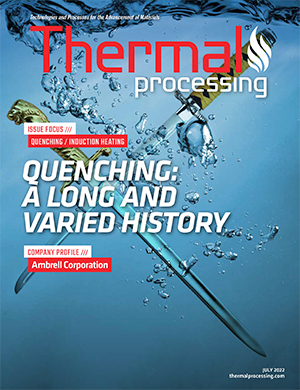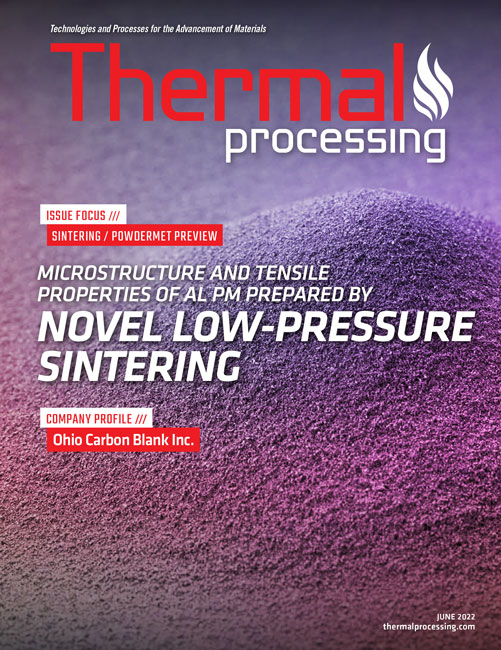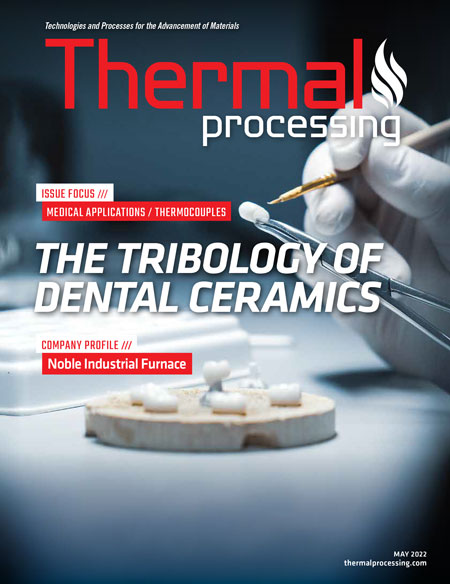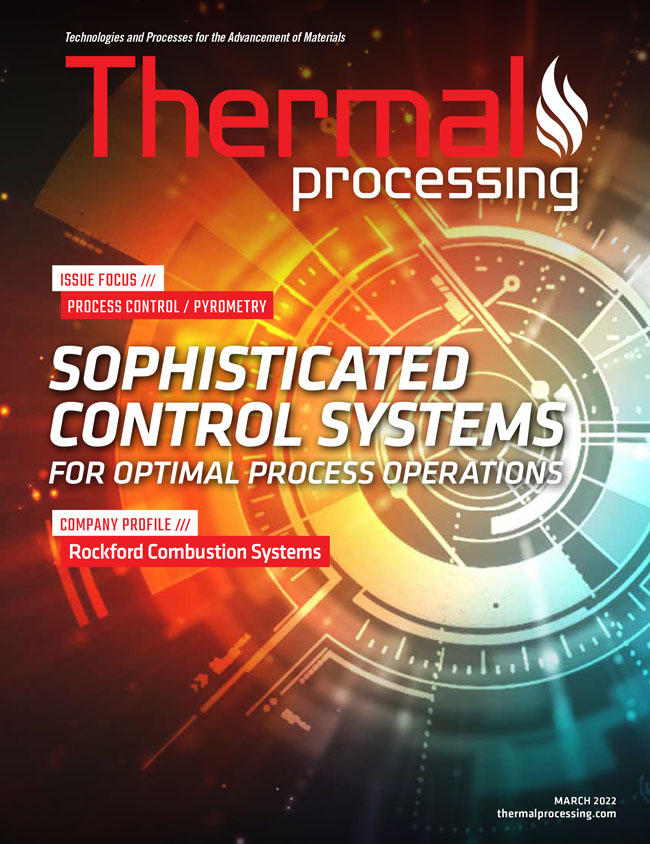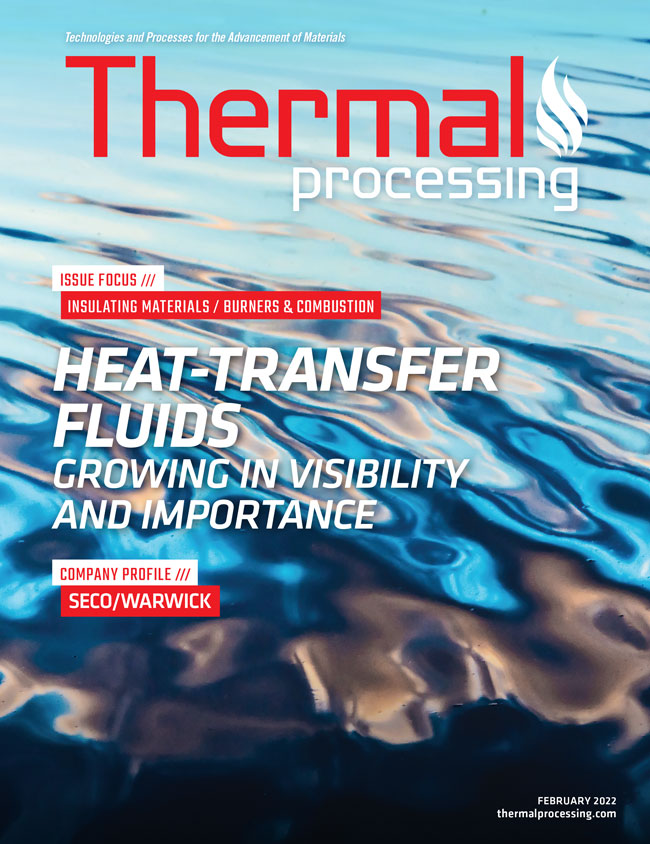Archives
December 2022
Plasma nitriding as a low-nitriding potential process
Plasma/ion nitriding is a process that can be easily applied to various high-alloy steels. Some of these steels — for example M-2, S-7, D-2, 43z40 steels — nitride very well. However, applications for making various tools require the layer is hard but does not endanger their fracture-toughness properties and, therefore, must not be brittle. Although […]
Heat treatment of steel measurement of hardness and tensile strength
The heat treatment of steel changes its microstructure, its hardness, and its tensile strength. These issues are of utmost importance as they are closely related to its uses and applications. This article is an experiment, conducted at the university laboratory of physical metallurgy. It assesses the abovementioned issues in the cases of various steel samples, […]
Investigating a new cooling technology for electric vehicles
The electric vehicle (EV) revolution is well underway: It’s estimated the number of EVs populating U.S. roads alone will double by 2024. And though the internal combustion engine (ICE) vehicle is a long way from disappearing, it’s anticipated EVs will continue to make up an increasing portion of the vehicle population around the world. As […]
October 2022
4D Quench: Taking aerospace to new heights
When providing heat treatment for aerospace gears and bearing components, manufacturers are traditionally left with three choices for thermal processing: continuous flow atmospheric furnaces with press quenching in oil, or batch heat treatment in both vacuum and atmospheric furnaces with quenching in oil (or high-pressure gas, as in vacuum). All three techniques differ in benefits […]
What ISO 17025 certification means for the heat-treating industry
ISO 17025 standards within the heat-treating industry are important when it comes to methods of calibration. This is especially important at BASF, a company whose product portfolio includes precious metal (PGM) thermocouples, IR optical pyrometers, thermocouple recycling services, and calibration services. BASF’s calibration laboratory is ISO 17025 accredited for calibration of several types of thermocouples […]
September 2022
Industrial ion nitriding of TMS 80 micro alloyed steel parts at various plasma power densities
Control of the ion nitriding process is typically based on temperature of the work piece, composition of the gas mixture, gas pressure, nitriding time, gas flow rate, plasma frequency, and duty cycle. It has also been known that plasma density may have an effect on the thickness of the nitrided layer and specifically the compound […]
Additive manufacturing and its road to industrial maturity
The American Gear Manufacturers Association’s (AGMA) Emerging Technologies Committee (ETC) recently organized a show floor tour of the Rapid + TCT Exhibition (Rapid). The ETC’s 3D Printing Sub-Committee (3DPC) has been monitoring the developments in the additive manufacturing (AM) industry for several years, providing AGMA members with distilled industry updates via webinars, white papers, and […]
Additive manufacturing: New frontiers for production and validation
Over the last few decades, additive manufacturing (AM)/3D printing has fundamentally changed the way that manufacturers approach product development. Industry is now almost universally aware of the term rapid prototyping, using AM to convert 3D CAD data into physical models in a matter of hours. The role of AM in prototyping has become embedded across […]
August 2022
Choosing between HFC and HFDu hydraulic fluids
While both HFC and HFDu hydraulic fluids reduce fire risk, improve operation safety, and enhance environmental performance, significant differences exist. Standing at 50 to 55 percent market adoption, HFC is a water-based fluid that can be used in all industries where there is a major risk of fire. In contrast, HFDu is a water-free fluid […]
Carbo-nitriding of forging dies
Forging dies have to resist high mechanical and thermal loads. Therefore, they are usually nitrided. Former investigations showed that the abrasive wear at the critical parts of the dies is much higher than the nitriding hardness depth. Carbo-nitriding offers the possibility to increase the hardness depth in shorter treatment times because of the higher treatment […]
July 2022
Quenching: A long and varied history
There have been many myths concerning the quenchants used by ancient blacksmiths in the heat treatment of swords and knives. Various liquids have been cited in the archeometallurgical literature as quenchants. Each of these quenchants is supposed to extend to the knife’s special and even mythical properties. Some possible quenchants used by ancient blacksmiths will […]
Preventing oxidation in the manufacturing of copper-titanium alloys
Due to their resistant and highly conductive properties, copper-titanium alloys become increasingly important in the field of industrially manufactured electrical components such as connectors, power switches, jacks, or camera modules. This trend is even more accelerated by the fact that titanium — as an alloying element — provides an excellent alternative to beryllium with its […]
Diffusion bonded printed circuit heat exchangers for severe environments
Traditional plate or shell and tube heat exchangers have long been used in processing industries. Today, however, with many new applications involving high pressures, temperatures, and exposure to corrosive environments, more manufacturers are turning to compact printed circuit heat exchangers (PCHEs). A PCHE is a multi-layer heat exchanger consisting of thin, flat metal plates into […]
June 2022
Microstructure and tensile properties of Al PM prepared by novel low-pressure sintering
This article proposes a novel low-pressure sintering process contraposing to characteristics of pre-alloyed aluminum powders and analyzes its feasibility. The low pressure was set to 0.1 MPa in this study. Meanwhile, 0 MPa and 10 MPa were set as the control group. With gas-atomized 2024 aluminum powders as raw material, the microstructure and tensile properties […]
Case study: Partnering with the medical industry
The high-tech medical industry is one of the most demanding in terms of standards, procedures, and technical parameters that must be met by the equipment involved in the production process. This is not surprising, because the complex components integral to medical equipment (e.g. RF components and components for X-ray tubes) must be characterized by maximum […]
May 2022
The tribology of dental ceramics
Ceramics are widely used in dentistry due to their ability to mimic the optical characteristics of enamel and dentine, as well as their biocompatibility and durability. They include a wide array of materials. There are three main classes of dental ceramics: predominantly glassy materials, particle-filled glasses, and polycrystalline ceramics (See Figure 1). In general, the […]
Enhanced thermal sensitivity in a single metal thermocouple
Single metal thermocouples (SMTs) have recently been developed with a new design concept of width-engineering of metal segments. In such designs, two segments of different micro-width are formed to obtain different levels of Seebeck effects. The variations in the Seebeck effect achieved from dissimilar segment width are small. In addition, the fabrication of such micro-width […]
April 2022
Gas solutions for sustainable metal AM
Sustainability is a key value driver and focus for industrial manufacturing, and additive manufacturing fulfills that need in more ways than one. Additive manufacturing, a rapidly maturing industrial technology, has great potential to reduce the energy and resource requirements of current labor-intensive manufacturing processes through efficient and compact design, precision-fit materials, fewer manufacturing steps, reduced […]
Carbon-neutral insulation for high-temperature applications
In January 2022, Mantec Technical Ceramics, based in Stoke-on-Trent, U.K., launched carbon neutral versions of its super-insulative Ultralite material, and this has been met with early success in user industries. To the best of the company’s knowledge, this is the first example of a U.K.-precision ceramics/refractories manufacturer attaining such certification. Ultralite grades ULF 10, 12, […]
March 2022
Sophisticated control systems for optimal process operations
A comprehensive control system, whether designing a new controls package or updating your existing system to a new controls scheme, is the most effective way to enhance any complex industrial manufacturing process — especially in more sensitive applications, such as coil coating or composite curing, where uniformity and precision are critical and when errors in […]
What pyrometer users need to know
Radiation thermometry, also known as infrared pyrometry, optical pyrometry, or simply pyrometry, is a non-contact temperature measurement technique that requires measurement of some portion of the thermal radiation given off by a hot object. The pyrometer, the measuring instrument, must look through some environment at the radiating target. There are several different types of pyrometer […]
The science of diffusion bonding or joining together dissimilar metals
Metal diffusion bonding is an essential joining method for achieving a high-purity interface when two similar metals require superior structural integrity. The process involves applying high temperature, and pressure to metals mated together in a hot press causes the atoms on solid metallic surfaces to intersperse and bond. There is probably no other commercially viable […]
February 2022
Heat-transfer fluids: Growing in visibility and importance
The growing use of electronics in many applications is leading researchers to better understand the reasons for using heat-transfer fluids. Electronics generate substantial amounts of heat, which needs to be dissipated in order to maintain performance. For the lubricant field, a primary example is the electric vehicle (EV). EV batteries need to operate at a […]
Combustion optimization in gas burners of reverberatory Furnaces during nickel-alloy melting
In recent years, due to climate change, environmental sustainability programs have been created that require the search for alternatives to reduce air emissions and reduce fuel consumption. The combustion industry is looking for an effective solution to increase the life cycle of its equipment and improve combustion efficiency without neglecting safety or savings. The efficiency […]
January 2022
Effect of heat and cryogenic treatment on wear and toughness of HSS AISI M2
Despite the promising results obtained with cryogenic treatment of tool steels, there are still contradictions regarding its benefits, and there is no consensus regarding its mechanisms in the steel microstructure. The goal of this work is to investigate the optimum heat treatment process parameters together with the cryogenic treatment. Samples of AISI M2 steel were […]
The impact of complete lubricant removal on the mechanical properties and production of PM components
The greatest hurdle in the production of powder metal components is lubricant removal. Over the years, equipment and processes have been developed to aid in the removal of the lubricant during the sintering process. Unfortunately, these technologies were not successful in removing all the lubricant. Recent developments in the sintering process have resulted in a […]
Vacuum heat treating and aluminum alloys
This study investigated the interface morphology, microstructure composition, and connection strength of 7A52 aluminum alloy-Al2O3 ceramic brazed joints under heat-treatment conditions. Alumina ceramics were first treated with electroless nickel plating, followed by vacuum heat treatment at different temperatures. Then, an Al-Si-Mg intermediate layer was placed between the treated alumina ceramic and 7A52 aluminum alloy for […]










